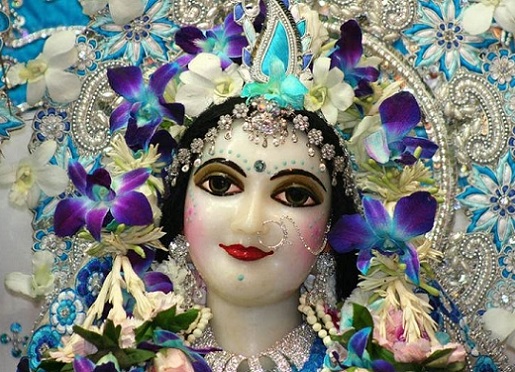(Srimati Radharani in Vrindavan—click to enlarge)
"Among the gopīs, Śrīmatī Rādhikā is the foremost. She surpasses all in beauty, in good qualities, in good fortune and, above all, in love."
(Caitanya-caritāmṛta Ādi 4.214)
"The beauty of Śrīmatī Rādhārāṇī’s eyes forcibly devours the beauty of newly grown blue lotus flowers, and the beauty of Her face surpasses that of an entire forest of fully blossomed lotuses. Her bodily luster seems to place even gold into a painful situation. Thus the wonderful, unprecedented beauty of Śrīmatī Rādhārāṇī is awakening in Vṛndāvana."
(Caitanya-caritāmṛta Antya 1.169, Purport)
"The beauty of Śrīmatī Rādhārāṇī is described as follows: 'Her eyes defeat the attractive features of the eyes of the cakorī bird. When one sees the face of Rādhārāṇī, he immediately hates the beauty of the moon. Her bodily complexion defeats the beauty of gold. Thus, let us all look upon the transcendental beauty of Śrīmatī Rādhārāṇī."
(Nectar of Devotion, Chapter 44)
"In the Vidagdha-mādhava, Second Act, verse 31, Kṛṣṇa tells His friend, 'My dear friend, what a wonderful thing it is that since I have seen the beautiful lotus eyes of Śrīmatī Rādhārāṇī, I have developed a tendency to spit on the moon and the lotus flower!' "
(Nectar of Devotion, Chapter 50)
"There is no comparison to Radharani's beauty and the luster of Her transcendental body. The so-called beauty of the moon has fallen on the ground in the presence of Radharani's beauty."
(From Vrindavana by Srila Narottama das Thakura)
"Śrīmatī Rādhārāṇī’s affection, Her exquisite beauty and good behavior, Her artistic dancing and chanting and Her poetic compositions are all so attractive that they attract the mind of Kṛṣṇa, who attracts the mind of everyone in the universe."
(Caitanya-caritāmṛta Madhya 17.212)
"Śrīla Rūpa Gosvāmī has stated that devotional service attracts even Kṛṣṇa. Kṛṣṇa attracts everyone, but devotional service attracts Kṛṣṇa. The symbol of devotional service in the highest degree is Rādhārāṇī. Kṛṣṇa is called Madana-mohana, which means that He is so attractive that He can defeat the attraction of thousands of Cupids. But Rādhārāṇī is still more attractive, for She can even attract Kṛṣṇa. Therefore devotees call Her Madana-mohana-mohinī—the attractor of the attractor of Cupid."
(Nectar of Devotion, Chapter 1)
"Srimati Radharani is the most beautiful, and She always enchants Krishna, but at the same time, Krishna is always the Enchanter of Radharani. This reciprocal attraction of Radharani and Krishna is the basic principal of Lord Caitanya's philosophy."
(Srila Prabhupada Letter, May 22, 1969)
"In the Caitanya-caritāmṛta it is said that when Kṛṣṇa comes before Rādhārāṇī, She becomes so much engladdened by seeing the beauty of Kṛṣṇa that She becomes more beautiful. And as soon as Rādhārāṇī becomes beautiful, Kṛṣṇa becomes engladdened and He becomes more beautiful. So unlimitedly there is competition of becoming more beautiful, duhe lage hurai... That is the statement. Competition. Because in the spiritual world everything is unlimited. So unlimitedly, both of Them becoming beautiful and both of Them enjoying unlimitedly. This is Kṛṣṇa consciousness."
(Srila Prabhupada Lecture, New Vrindavan, September 6, 1972)
"In the Lalita-mādhava, Rūpa Gosvāmī explains that the movements of Kṛṣṇa's eyebrows are just like the Yamunā, and the smiling of Rādhārāṇī is just like the moonshine. When the Yamunā and the moonshine come in contact on the bank of the river, the water tastes just like nectar, and drinking it gives great satisfaction. It is as cooling as piles of snow."
(Nectar of Devotion, Chapter 44)
"In the words of Vaiṣṇava poets, it is said that the Lord's beauty is so enchanting that it defeats hundreds of thousands of Cupids. He is therefore called Madana-mohana. It is also described that the Lord sometimes becomes mad after the beauty of Rādhārāṇī. Poets describe that under those circumstances, although Lord Kṛṣṇa is Madana-mohana, He becomes Madana-dāha, or enchanted by the beauty of Rādhārāṇī. Actually the Lord's beauty is superexcellent, surpassing even the beauty of Lakṣmī in Vaikuṇṭha. The devotees of the Lord in the Vaikuṇṭha planets want to see the Lord as the most beautiful, but the devotees in Gokula or Kṛṣṇaloka want to see Rādhārāṇī as more beautiful than Kṛṣṇa."
(Śrīmad-Bhāgavatam 3.15.42, Purport)
"Kṛṣṇa is the most beautiful, Rādhārāṇī is the most beautiful. Couple, young couple. Our object of worship when we see how nice Rādhārāṇī, how nice Kṛṣṇa, beauty. Yes. Wherefrom the beauty worship has come in this material world unless there is beauty in the original form, Kṛṣṇa and Rādhārāṇī? So God cannot be nirākāra (without form). Otherwise, why this beauty worship has come?"
(Srila Prabhupada Lecture, Bombay, October 13, 1973)
"Rādhe jaya jaya madhava-dayite. How She is? Gokula-taruṇī-maṇḍala-mahite. Taruṇī, taruṇī means young girls. You'll see the pictures, they are all young girls. But of all the young girls, She is the most beautiful. She is enchanting to the young girls also. She is so beautiful. Gokula-taruṇī-maṇḍala-mahite. Dāmodara-rati-vardhana-veśe. And She always dresses Her so nicely that Dāmodara, Kṛṣṇa, becomes attracted by Her beauty. Hari-niṣkuta-vṛndā-vipineśe. And She is the only lovable object of Kṛṣṇa, and She is the queen of Vṛndāvana. This queen of Vṛndāvana."
(Srila Prabhupada Lecture, Montreal, August 30, 1968)
"Madana means Cupid. Cupid enchants everyone. Cupid. And Kṛṣṇa enchants Cupid. Therefore His name is Madana-mohana. He's so beautiful that even Cupid is enchanted by Him. But again on the other side, Kṛṣṇa, although He's so beautiful that He enchants the Cupid, still He is enchanted by Śrīmatī Rādhārāṇī. Therefore Śrīmatī Rādhārāṇī's name is Madana-mohana-mohinī. Kṛṣṇa is the enchanter of the Cupid, and Rādhārāṇī is the enchanter of that enchanter. So these are very high-grade spiritual understanding in Kṛṣṇa consciousness. It is not fiction or imagination, concoction. They are facts. They are facts. And every devotee can have such privileges if he is actually advanced."
(Srila Prabhupada Lecture, Los Angeles, April 23, 1973)
